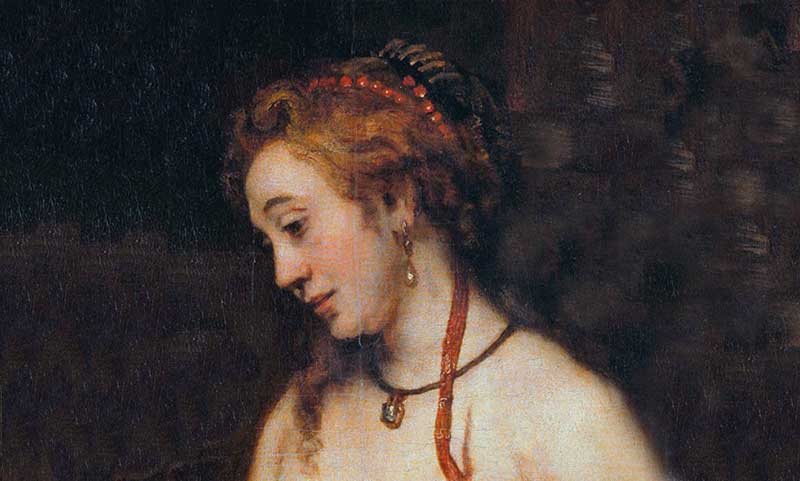
According to the Books of Samuel, Bathsheba was the wife of Uriah the Hittite, an elite soldier in the army of David, the king of Israel and Judah. One day, while she was taking her bath, King David accidentally noticed her from the roof of his palace and was immediately attracted by her magnetic beauty. As he became desperate to have sex with her, he summoned her to his palace with a letter and forced to sleep with him.
After some time, when Bathsheba found herself pregnant, she sent word to the king, likely in a panic and to cover up his adultery and Bathsheba’s pregnancy, the king sent her husband into a battle and instructed his generals to abandon him, thus leaving him to certain death. After his death, David married Bathsheba and eventually, she became the mother of King Solomon.


‘Bathsheba at her Bath’ was painted by Rembrandt in 1654 and now hangs in The Louvre. It depicts the biblical figure Bathsheba completely nude, sitting on pure white drapery with a letter in her hand and lost in a moment of contemplation. The painting is dark, suffused with a deep, rich, black background that seems to sink back forever, while an attendant washes her feet. It is a life-sized painting and the figure of Bathsheba dominates the canvas. Rembrandt painted Bathsheba from a live model, Hendrickje Stoffels, who had previously been his maid and lived with her as a couple, after the death of his wife.
Each fold of her triumphant flesh is lovingly detailed in his canvas, its eroticism highlighted by the fine, soft and transparent drapery, along with delicately worked jewelry. The figure of Bathsheba in the painting is not a figure of perfection. She does not have the flat stomach of a supermodel, as she is simply a woman with a woman’s normal body shape, but it does not lose its sense of eroticism and beauty. The position of her slightly tilted head with its idealized profile was carefully planned and her open sensuality contrasts with her air of profound sadness, which reflects her tension, as she gazes resignedly into the space, sadly accepting her fate.

The idea of Bathsheba taking her bath in the nude has inspired many artists, including Cornelis Bisschop (Dutch 1630–1674), Nikolaas Verkolje (Dutch 1673–1746), Jean François de Troy (French 1679–1752), François Boucher (French 1703–1770), David Wilkie (British 1785-1841), Francesco Hayez (Italian 1791–1881) and Paul Cézanne (French 1839-1906).
Most of them took the opportunity to depict the female nudity in the wilderness with her handmaidens as part of an outdoor scene and often they incorporated the figure of David, stealthily gazing at her the attractive naked body. However, Rembrandt ignored the presence of David in his canvas and instead he depicted Bathsheba alone except for her maid who is bathing her feet. She knows that she is going to betray her husband and the sadness in her eyes reflects her guilty conscience. Rembrandt's skill in depicting light to create the atmosphere was at its height in this becalmed, mature work.
